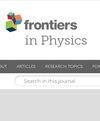What do we learn from impurities and disorder in high-Tc cuprates?
IF 1.9
3区 物理与天体物理
Q2 PHYSICS, MULTIDISCIPLINARY
引用次数: 0
Abstract
A series of experimental studies established that the differing morphologies of the phase diagrams从高碲铜氧化物的杂质和无序中我们能学到什么?
一系列实验研究表明,不同铜氧化物家族的相图形态与空穴掺杂量 nh 的关系主要受缺陷和无序控制。在无序度极低的铜氧化钇(YBCO)中,我们引入了可控的缺陷,从而能够探测金属态和超导态。我们证明,自旋玻璃相和超导穹顶的程度可以通过平面铜位点上取代的无自旋(锌、锂)杂质浓度来控制。核磁共振频移测量证实,这些缺陷会在其附近诱发具有近藤顺磁行为的云。它的 "Kondo "温度和空间范围在伪间隙和奇异金属状态下有明显差异。我们对通过电子辐照引入的面内空位含量可控的单晶体进行了传输测量。研究发现,在高 T 时,载流子的非弹性散射与无序无关,完全受相关电子态的激发控制。与单点近藤散射相关的电阻率低 T 上升与无自旋杂质诱导的局部磁性在性质上是一致的。只有在缺陷含量非常大的情况下,才能检测到明显的金属绝缘体交叉,大电阻率上升的一部分仍然与近藤样顺磁性有关。在超导状态下,缺陷引起的 Tc 下降与无序引起的残余电阻率上升成线性比例。通过高场磁阻实验,我们可以确定超导波动引起的副导性。后者在温度 T'c 和磁场 H'c 之后消失,而温度 T'c 和磁场 H'c 都会随着面内缺陷含量的增加而降低。在伪隙机制中,T'c 相对于 Tc 的减小程度较弱,这表明在存在无序的情况下,超导相干性会大量丧失。根据我们的实验结果,我们开始讨论它与配对断裂之间的相互作用。我们的数据还使我们能够确认,不同的相图是由于竞争秩序或家族特有的无序造成的。在无序杯石的理想相图中,二维超导性应在低掺杂时持续存在。这一系列实验结果为理论上理解这些相关电子系统的超导性提出了严峻的挑战。
本文章由计算机程序翻译,如有差异,请以英文原文为准。
求助全文
约1分钟内获得全文
求助全文
来源期刊

Frontiers in Physics
Mathematics-Mathematical Physics
CiteScore
4.50
自引率
6.50%
发文量
1215
审稿时长
12 weeks
期刊介绍:
Frontiers in Physics publishes rigorously peer-reviewed research across the entire field, from experimental, to computational and theoretical physics. This multidisciplinary open-access journal is at the forefront of disseminating and communicating scientific knowledge and impactful discoveries to researchers, academics, engineers and the public worldwide.
 求助内容:
求助内容: 应助结果提醒方式:
应助结果提醒方式:


